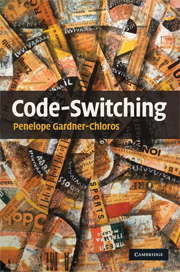Book contents
- Frontmatter
- Contents
- Acknowledgements
- Transcription conventions
- 1 Introduction
- 2 Code-switching and language contact
- 3 Social factors in code-switching
- 4 Code-switching in conversation
- 5 Grammatical aspects of code-switching
- 6 Psycholinguistic approaches
- 7 Acquiring code-switching: code-switching in children (and L2 learners)
- 8 Conclusions
- Appendix
- Bibliography
- Index
5 - Grammatical aspects of code-switching
Published online by Cambridge University Press: 10 February 2010
- Frontmatter
- Contents
- Acknowledgements
- Transcription conventions
- 1 Introduction
- 2 Code-switching and language contact
- 3 Social factors in code-switching
- 4 Code-switching in conversation
- 5 Grammatical aspects of code-switching
- 6 Psycholinguistic approaches
- 7 Acquiring code-switching: code-switching in children (and L2 learners)
- 8 Conclusions
- Appendix
- Bibliography
- Index
Summary
Introduction
Grammatical approaches have been one of the most prolific sub-fields in the study of CS, and there a number of useful summaries of work in this area (e.g. Bhatia and Ritchie, 1996; Muysken, 2000). The volume of work on CS from this perspective derives from the light which it can cast on grammatical theories: “When sentences are built up with items drawn from two lexicons, we can see to what extent the sentence patterns derive from the interaction between these two lexicons” (Muysken, 1995:178). The purpose of this chapter will not be to give a full picture of the theories, since these have been described thoroughly elsewhere (Myers-Scotton, 1997; Muysken, 2000). Instead there will be a brief overview, the emphasis being put on the role which grammar can play in our understanding of CS – i.e. a reversal of the normal formula. It will be argued that the grammatical work done on CS so far has failed to take the variations in code-switching behaviour sufficiently seriously. Rather than being peripheral issues, which can be treated under the heading of exceptions or instances of some other phenomenon such as borrowing, the variations in CS grammars should be taken as the central issue to investigate. Grammatical explanations of CS will be more satisfactory to the extent that they can take on board the variations related to differences in competence between speakers, differences related to typological factors and differences due to sociolinguistic parameters – all of which have often so far been regarded essentially as an inconvenience.
- Type
- Chapter
- Information
- Code-switching , pp. 91 - 116Publisher: Cambridge University PressPrint publication year: 2009



